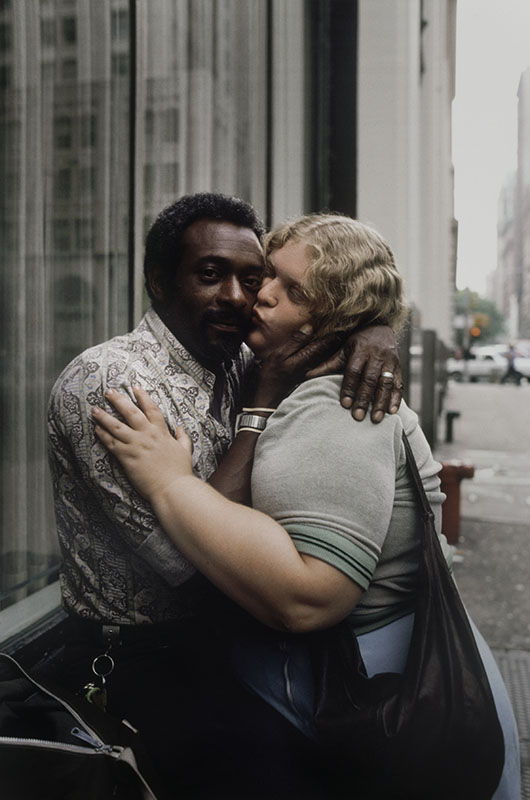Time has been good to the work of Arlene Gottfried ’72, the street photographer who captured down-at-the-heels New York with a singular blend of affection, irony, and an eye for serendipity. From the 1970s until her death from cancer in 2017, she trawled the city, shooting strippers, transgendered people, interracial couples, and countless members of the African-American and Puerto Rican communities, with what The New Yorker called a “fantastic openness.”
The New York Times, Time, Life, and other outlets ran her pictures. But this unassuming artist made her greatest work for herself. In 1984, she began photographing an eccentric friend, a nightclub dancer named Midnight. Gottfried spent the next 18 years documenting his slide into schizophrenia and homelessness, but she never considered the photos a formal project; she kept them in a shoebox. In the early 2000s, when her freelance work slowed down, she began to show the images to friends. “People would cry when they saw them,” she said in a lecture. “That’s when I knew I had something.” In 2004, she published the book Midnight, an unflinching yet compassionate study of a life in freefall. A collection of photos about New York’s vibrant Puerto Rican community, Bacalaitos and Fireworks, was laid out in 1991 but only printed in 2011.
Gottfried grew up in an apartment above her father’s hardware store in Coney Island, and later on the Lower East Side, places she returned to repeatedly in her work. She took night classes in Photography at FIT because, she said, it was what her parents could afford. Her classmates and teachers were all male. Afterward, she took a few of the traditional photo assistant jobs but, she once said, “They didn’t think women could do the work or carry the equipment.” She spent much of her career developing images for an advertising agency.
Her book Mommie attests to the importance of family in her life. It portrays three generations of Gottfried women: grandmother, mother, sister. The grandmother emerges as fiercely independent and idiosyncratic. (Gottfried loved photographing her grandmother kissing her mother on the lips to say goodbye.) With profound intimacy, the book bears witness to the mother’s agonizing final illness and death. “I was trying to stop time,” Gottfried explained, “which of course I couldn’t do.” There is joy, too: Late in life, her sister decided to have a baby. The cycle of birth and death in Mommie manages to be both archetypal and achingly particular. Time named it Best Photobook of 2016.
Largely absent from the work is the artist’s younger brother, comedian Gilbert Gottfried, though the siblings were close, and they encouraged each other in their careers. “In the early years,” Gilbert recalled in a conversation with Hue, “New York was totally different. There were bombed-out areas—like war zones, practically. But Arlene loved how they looked. She saw it all affectionately.” Her best work captures the city’s misfits and marginalized, with whom she identified. “I don’t think they’re freaks, because then I’d be a freak too,” she once said. Daniel Cooney, whose gallery represents her work, said humanity is her hallmark: “There’s never a picture where she’s looking down at someone, judging them, or laughing at them.”

Gottfried loved to wander, and one advantage of her easy identification with strangers is that she was comfortable everywhere. “I feel at home in a lot of different places,” she said. Though her family were nonobservant Jews, in the early 1990s she became fascinated with a Pentecostal gospel choir, made up largely of African-American members. One day, she once explained, she felt moved to join the singers: “The same force that pulled me to them pulled me further. It was a long process to learn to sing that way, with all your might.” Her mother dubbed her “the singing photographer.” Gottfried published a book of photos about the group, The Eternal Light.
It wasn’t until she was in her 50s that she began to publish monographs. Cooney produced her first solo, commercial gallery show in 2012. Perhaps Gottfried was right when she told her brother, “They’ll recognize me when I’m dead.” After her death, major publications ran her images, along with thoughtful appraisals. Gothamist called her an “NYC treasure.” Though she continued to photograph until last year, shooting in both black and white (which she printed herself) and color (she was heartbroken when Kodak discontinued Kodachrome), the early work remains the most striking. Gottfried felt New York had become less interesting over time. The New Yorker said her images show “a city that’s been priced out of its own identity.” They also record moments when an artist looked at our strange, strange world and felt an uncanny glimmer of recognition.
Gottfried was also an enthusiastic gospel singer. Here she is singing the standard “God Cares.”
